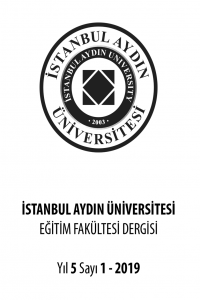Bir Eylem Araştırması: Edebiyat Gruplarının İlköğretim Öğrencilerine İngilizce Öğretiminde Kullanımı
Öz
Bu eylem araştırması ilköğretim öğrencilerinin İngilizce derslerinde
edebiyat gruplarının kullanılmasının öğrencilere iş birliği, farklı bakış
açıları kazanma, yetenekleri ortaya çıkarma, öz güven geliştirme,
iletişim ve düşünme becerilerini geliştirme, kelime haznesi oluşturma ve
ayrıntıları yakalama açısından katkılarını gözlemlemek ve bu çalışmayı
uygularken İngilizce öğretmenlerinin karşılaşabileceği olası zorlukları
saptamayı hedeflemiştir. Bu çalışma, 2018-2019 akademik yılının ikinci
döneminde İstanbul’da özel bir ilköğretim okulunda gerçekleştirilmiştir.
Araştırmaya, İngilizce düzeyleri başlangıç seviyesinde olan 18 ilköğretim
üçüncü sınıf öğrencisi katılmıştır. Çalışma verileri araştırmacı günlüğü,
yarı yapılandırılmış görüşmeler, değerlendirme ölçütleri, öz değerlendirme
listeleri ile öğretmen gözlem günlüğünden oluşmaktadır. Bu çalışmanın
sonuçları edebiyat gruplarının ilköğretimde İngilizce derslerine
uygulandığında öğrencilerin okudukları otantik hikâyelerin düşünme,
tartışma ve yorum yapma becerilerinin gelişmesine ve bu hikâyelerin
içerdikleri kavramlar ile oluşan edebiyat gruplarında çalışan öğrencilerin de
öğrenme süreçlerinin sorumluluğunu alma noktasında ilerleme kaydettiği
gözlenmiştir.
Anahtar Kelimeler
Okuma Otantik Hikâyeler Kavram Bazlı Okuma edebiyat grupları
Kaynakça
- Broughton, G., C. B., R. F., P. H., & A. P. (1980). Teaching English as a foreign language. London: Routledge and Kegan Paul. Burke, K. (2014). Balanced assessment from formative to summative. United States, Indiana: Solution Tree. Burns, A. (2010). Doing action research in English language teaching: A guide for practitioners. New York: Routledge. Daniels, H. (1994). Literature circles: Voice and choice in the childcentered classroom. York, ME: Stenhouse Daniels, H. (2002). Literature Circles: Voice and Choice in Book Clubs and Reading Groups. Stenhouse. Daniels, H. (2006). What’s the Next Big Thing with Literature Circles? Voices from the Middle, 13, 4th ser. Retrieved March 2, 2019, from http://www.csun.edu/~krowlands/Content/Academic_ Resources/Literature/Instructional Strategies/Daniels-lit circles.pdf Furr, M. (2004). Literature Circles for the EFL Classroom. Proceedings of the 2003 TESOL Arabia Conference. Retrieved March 27, 2019, from esourcesforteflteachers.pbworks.com/f/Literature Circles for EFL Students.pdf. McKay, S. (1982). Literature in the ESL Classroom. TESOL Quarterly,16(4), 529. Retrieved March 6, 2019, from http://www. jstor.org/stable/3586470 Pilkey, D. (2004). Dog breath: The horibble trouble with Hally Tosis. New York: Scholastic. Pritchard, R. J. (March 1993). Developing Writing Prompts for Reading Response and Analysis. Retrieved April 28, 2019, from https://www. researchgate.net/publication/270802874_Developing_Writing_ Prompts_for_Reading_Response_and_Analysis The English Journal,82(3), 24 Serravallo, J. (2010). Teaching reading in small groups: Differentiated instruction for building strategic, independent readers. Portsmouth, NH: Heinemann. Short, K. G. (1999). Learning together through inquiry: From Columbus to integrated curriculum. York, Me.: Stenhouse. Widdowson, H. G. (1996). Teaching language as communication. Oxford: Oxford Univ. Press. Widdowson, H. G. (2003). Defining issues in English language teaching. Oxford: Oxford University Press.
Ayrıntılar
| Birincil Dil | İngilizce |
|---|---|
| Konular | Eğitim Üzerine Çalışmalar |
| Bölüm | Makaleler |
| Yazarlar | |
| Yayımlanma Tarihi | 1 Nisan 2019 |
| Yayımlandığı Sayı | Yıl 2019 Cilt: 5 Sayı: 1 |
All site content, except where otherwise noted, is licensed under a Creative Common Attribution Licence. (CC-BY-NC 4.0)



